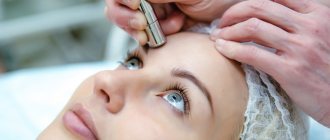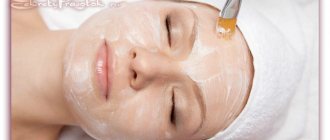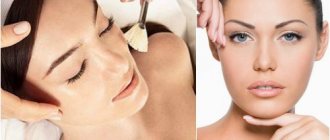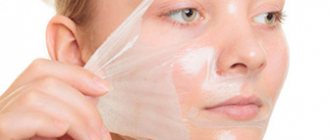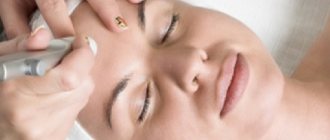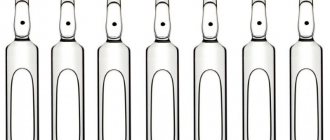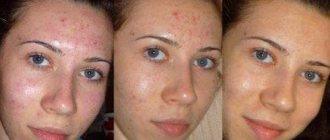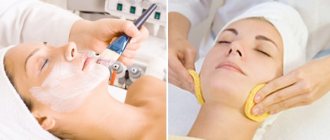What is enzyme peeling and how to properly use products with enzymes? I tested mass market peelings, and also give examples of enzyme peelings from professional brands.
- Why is it necessary to deep cleanse your skin?
- What is Enzyme Peeling
- Budget peeling test from Lirene
- The cost of peeling and how to store cosmetics
- Tips for using peels at home
- Professional enzyme peels for home use
Watch video on YouTube:
Enzyme peeling at home - instructions
It is worth immediately noting that for enzyme peeling in the salon, stronger drugs are used, so salon procedures are much more effective than home ones. But due to the fact that enzyme peeling is very soft and non-traumatic, it can be used at home without any problems. The enzyme peeling procedure should follow the following scheme :
- Cleansing facial skin with lotion suitable for skin type.
- Apply pre-peeling solution to the skin of the face, eyelids, neck, and décolleté. The solution must be applied to all areas of the skin that will be peeled, without missing areas, in order to avoid the occurrence of inflammatory processes or allergic reactions on them.
- Applying an enzyme product to the skin , which must be kept on the skin for 20 minutes. In the absence of hypersensitivity of the skin, the enzyme peeling procedure can be extended to 30 minutes.
- Rinse off the enzyme product from the skin with a very large amount of clean water.
After the peeling procedure, a woman may feel a slight burning, tingling, or “burning” sensation on her skin. These phenomena will soon pass, they indicate that the enzyme peeling procedure at home was carried out correctly, and the effect is present .
“Stopproblem”
Salicylic enzyme peeling, popular among ladies in Russia and near Russia, from the conventionally pharmacy but extremely budget-friendly brand “Stopproblem” combines the capabilities of light acidic (salicylic acid) and enzymatic (special complex of substances) preparations.
The pros and benefits of the product:
- accessibility, both price and physical. It is worth admiring the work of marketers and brand designers: the first impression of “medicine” and “medicine” arises only from a brief glance at the packaging of any brand product, automatically increasing confidence in the ingredient composition and promises. The blue-red-white tones of the packaging, medical symbols, combined with the cost of about 150-200 RR per 100 ml seem to many users to be a fairy tale and an immediate panacea...
- a sufficient percentage of positive reviews. Users who use this drug as basic care note that the actual results correspond to those declared by the manufacturer. When used for oily skin with a small number of rashes, and also as an express therapy, the product really refreshes and evens out the epidermal relief, cleanses pores, has some astringent effect and can even prevent rashes, but...
Minuses:
- Enzyme peeling “StopProblem” is categorically not indicated for use by owners of dry, sensitive, combination skin with a high difference in hydration in key areas (forehead-cheekbones), dehydrated;
- its use on the above types of facial skin leads to a severe deterioration of the condition, including dermatoses and eczema.
Before and after use
Let's confirm with reviews from the open spaces:
“I use it all the time, and I bought it along with the lotion. The skin is not at all sensitive, thick, there is a lot of sebum, so much so that in the summer it sometimes drips, and it’s not sweat! So I’ve been using StopProblem for over a year now. Since neither the list of food consumed, nor the lifestyle, nor even the apartment or water changed, and the situation leveled out to an acceptable... Well... Not that gloss and apples, as in the photo, but... You know, this summer only at 4 pm the skin I wipe it with lotion, and before that in the morning around seven. There is less fat, the appearance is more pleasant and the color is better. In general, stopproblems suited me and I am very pleased with it. Cheap and cute!”
“Very harsh cosmetics. There may be no alcohol, but this salicylic acid and b. knows what else, they burned my cheeks from my temples to my nose. It was peeling, red as if burned, and my face hurt for a week. I was treated with ointments and lotions for about three months. The skin was also oily. That is, I thought she was fat. Then the pharmacist said that my face, hair, even nail plates were very dry. And under no circumstances was this possible. Who would have known before, right? So let anyone take this much-vaunted stopproblem, I literally got burned.”
In what cases is this exfoliating procedure prescribed?
Enzyme peeling can be carried out both according to the indications of a cosmetologist and as home care. Enzymatic peeling is prescribed for the following reasons:
- As preventive care.
- To smooth out acne marks.
- To get rid of fine wrinkles.
- For skin contamination with comedones and milia.
- To even out skin color.
- To increase skin elasticity.
- In preparation for deeper peels and cosmetic procedures.
- To lighten age spots.
- For enlarged pores.
- For the treatment of acne.
As we can see, the list of indications for peeling is quite long: the procedure is carried out both to treat problematic skin and as a preventive measure, to refresh the skin.
What is enzymatic or enzyme peeling?
Enzyme peeling is a cosmetic procedure aimed at renewing the skin using enzymes.
Enzymes are molecules that can break down proteins. Scientifically, they are called proteases. The epidermal tissues have their own proteases that regulate the renewal of the stratum corneum of the skin. With age, their activity decreases significantly and the skin simply does not have time to cleanse itself of horny scales and impurities. Because of this, it loses its former smoothness and elasticity and acquires a painful grayish tint.
Enzyme peeling is aimed at using enzymes to cleanse the skin, heal and rejuvenate it.
Composition and features
The main active ingredients included in all enzyme peels are enzymes of various origins: plant, animal, bacterial. In addition, milk proteins are used. Below we will consider the features of each type of enzymes, but for now we note that the essence of peeling comes down to saturating the stratum corneum with substances that break down keratin and, as a result, the horny scales come off much easier.
The peculiarity of the enzymes included in the composition is that their action does not extend beyond the stratum corneum of the epidermis , but despite the gentle mechanism of their action, they effectively stimulate the production of fibroblasts, which accelerates skin renewal, and also cleanses it of dead cells.
Many clients note that with regular cleansing courses, the signs of skin aging are significantly reduced, acne marks and small scars become less noticeable.
But despite the gentleness of the procedure, peelings should not be overused - this can have the opposite effect than intended. The epidermis will dry out, its protective functions will be impaired, and the skin will become duller. Therefore, it is important to follow the advice of professionals and carry out peeling according to the prescribed scheme .
Efficiency
Enzymatic peels are considered not too powerful - they cannot affect deep wrinkles and old age spots. However, many people prefer them for their gentle mechanism of action, absence of peeling and painful rehabilitation period.
Note! Enzyme peeling is classified as superficial and does not affect deep scars.
Using enzyme peeling:
- the work of the sebaceous glands is stabilized;
- skin tone is evened out;
- pigment spots become lighter;
- skin turgor increases.
Thus, when carrying out enzymatic peeling, you should not count on getting rid of deep wrinkles or long-standing effects of acne. This procedure is considered gentle and is aimed at refreshing the skin and improving its appearance.
We recommend: Rejuvenating peeling with succinic acid for the face: what is this procedure and how is it carried out?
Enzyme peeling results: before and after photos
The result of enzyme peeling procedures is radiant, moisturized skin . With age-related, aging skin, the rejuvenation effect is very pronounced - the skin tightens, acquires tone and elasticity . The skin acquires an even color, slightly brightens, and evens out . It is worth noting that with deep scars on the skin and wrinkles, enzyme peeling does not bring miracles - it only improves the general condition of the skin, but cannot get rid of large defects. As a rule, enzyme peeling in salons is used as a preliminary procedure before a series of other, more effective and powerful cosmetic procedures. The effect of enzyme peeling is often compared to the effect of fruit masks - the skin acquires elasticity, strength, beautiful color and tone . Benefits of enzyme peeling:
- This procedure stimulates the processes of epidermal cell renewal and skin rejuvenation.
- Enzyme peeling evens out skin tone , eliminates age spots, freckles, and brightens hyperpigmented areas of the skin.
- Enzyme peeling procedures increase the tone, firmness and elasticity of facial skin.
- After enzyme peeling, women note that the skin becomes radiant, healthy , and its general condition improves.
Best Recipes
There are quite a lot of recipes for enzyme peeling at home. The procedure does not require exotic and expensive ingredients, which means that the purchase will not be so expensive. So, let's look at several options for home enzyme peeling.
Pumpkin and mango puree
Ingredients:
- Medium size lime – 1 pc.
- Papaya enzyme – 3 tablets.
- Pumpkin pulp - 1 tbsp. l.
- Mango – 1 tbsp. l.
Method of preparation and use:
- Squeeze the lime in a juicer.
- Grind papaya tablets into powder.
- Grind mango and pumpkin in a blender.
- Mix all ingredients.
- Apply to face and after 10 minutes, rinse with running water.
Honey and soy milk
You will need the following components:
- Fresh pumpkin puree – 2 tbsp. l.
- Soy milk – 1 tbsp. l.
- Liquid honey - 1 tbsp. l.
Cooking method:
- Pumpkin puree, honey and soy milk are combined.
- Mix the ingredients thoroughly until a homogeneous mass is obtained.
- Apply with massaging movements to the face.
- Cover the top with a towel and leave for 10–15 minutes.
- Then rinse with warm water and apply moisturizer.
To increase the effectiveness of the procedure, before covering your face, it is recommended to soak the towel generously in hot water and wring it out a little.
Advantages and disadvantages
The procedure, which uses an enzymatic effect on the upper layer of the dermis, is gentle and has a minimum of contraindications, this is its main advantage. In addition, it has the following advantages:
- gives a pronounced rejuvenating effect;
- stops aging;
- removes toxins;
- tightens pores;
- helps remove age spots and freckles;
- used not only in the cold season, but also in summer or spring;
- does not require long-term rehabilitation;
- not prohibited for pregnant women.
Cleaning with enzymes is not without its drawbacks. First of all, it is not suitable for correcting aging skin. This type of peeling cannot cope with deep wrinkles and strong pigmentation; more aggressive techniques are needed. You can also note the following disadvantages:
- does not remove scars;
- may cause complications;
- You can't clean it very often.
If we compare, the procedure has many more advantages than disadvantages, which is why it has a whole army of loyal fans. Judging by the reviews, this is one of the most popular types of peeling.
"I am the"
In the next issue we will talk about the enzyme peeling “Ya Samaya”, about which reviews are much less emotional and widespread, but this can be explained by some of the novelty of the drug.
The price category and volume are identical to the above-described “Stopproblem”, but “Ya Samaya” works on the most waste enzyme - papain. In addition to papain, the drug contains aloe extracts, vitamins BB, A, E. Let us take the liberty to believe that the concentration of papain in a home care product is unlikely to have an anti-aging effect, as well as whitening, anti-acne, etc. But, like in the case of “Stopproblem”, this enzyme peeling, being in an adequate price category, enjoys a certain popularity.
“Do you know what this peeling with papain from Yasamaya reminded me of? Oriflame. They had one like this, but haven’t seen it anywhere for a long time. A little white powder, you know, you had to sprinkle a little water on your palm and some water. Then it became foam and hissed a little; you had to rub it over your face and wash it off. The smell was so wonderful, I didn’t miss this foam so much as I missed the smell. Only fruits, or something else. Maybe mango or this papaya, I don’t know. The effect, I remember, was not just wonderful, but it smelled. So, “Ya Samaya” also smells great, but about the effect something like this... Maybe I haven’t tried it. Well, every night, they say, it will be too much.”
“How do you find it and most importantly where?!! Wherever I go, wherever I ask, everywhere it’s JUST ENDED!!! Just like bread during the war. It can't be so popular or what's wrong with him? If you see where, be sure to tell me! You can even buy it, I’ll send you money and even pay for the parcel! Like when hunting, honestly, it’s unclear what the product is and it’s impossible to buy. Are they still making it, or maybe that’s it already?”
Advice from cosmetologists
Experts recommend enzyme peeling for the following reasons:
- Peeling products have a low pH.
- The composition of the products does not have a negative effect on regenerative processes.
- Great for women who want a velvety and silky surface, as well as to hide marks from cyperosis and blackheads.
In addition, cosmetologists advise purchasing only high-quality and proven products. Various analogues in a cheaper price category are not always able to show decent results. Therefore, you should not skimp on your health. Before choosing one or another product, you still need to consult with a specialist, and then you will be able to avoid possible problems with the skin.
How often can you do enzyme peeling?
Since enzyme peeling preparations do not contain solid scrubbing particles, but exfoliate dying skin cells only when exposed to fruit acids, enzyme peeling is considered very soft and delicate. But, nevertheless, when carrying out procedures of this type of peeling, it is necessary to be guided by common sense and the advice of cosmetologists. Enzyme peeling can be done once or twice a week . But, if you have dry skin, then procedures can be performed no more often than once every 7-10 days . For oily and combination skin that is not prone to sensitivity, irritation, or inflammation, enzyme peeling procedures can be performed up to 3 times a week .
Indications and contraindications
Indications for enzyme peeling
- Clogged pores.
- Photoaging of the skin.
- All skin types.
- Decreased tone.
- Superficial fine wrinkles.
- Dark spots.
- Dull skin color.
- Can be performed on people with dark skin.
- Skin contamination.
- Acne and its consequences.
- Preparation for more complex procedures.
Contraindications to enzyme peeling
- Active form of the herpes virus.
- Exacerbation of skin diseases.
- Diseases that reduce immunity, including diabetes.
- Damage to the skin.
- Individual intolerance to drugs used during the procedure.
Frequency of the procedure
Enzymatic peelings require courses. As a rule, the course includes up to 8 procedures with an interval of 3–7 days.
Products for professional use may contain acids, so it is enough to perform 1 procedure every 1–1.5 weeks. In total, up to 10 such procedures will be required.
Enzymatic peelings are a gentle and painless cleansing. Within half an hour after this procedure, you can do your favorite things and enjoy soft and delicate skin without blemishes.
What are the difficulties?
Even after gentle and safe enzyme cleaning, complications can arise. Patients should be prepared for the following:
- Exacerbation of herpes. To prevent this from happening, you should take antiviral drugs a few weeks before the procedure if you have a history of such a disease.
- Acne. The procedure can provoke an exacerbation of the disorder, despite the fact that it is aimed at suppressing it. In rare cases, the body reacts to cleansing in this way.
- Seborrheic dermatitis. It occurs in rare cases and is an unpredictable complication.
Choosing a good professional and detailed diagnostics before cleaning will help you avoid adverse reactions. You should also strictly follow the recommendations of doctors during the rehabilitation period.
Skin care rules after the procedure
The rules for caring for facial skin after peeling are quite simple and do not require the expenditure of time and energy. To do this, you just need to follow the following rules:
- Avoid direct exposure to sunlight.
- Do not touch your face immediately after the procedure and refrain from doing so for several hours.
- Do not expose the skin to mechanical stress.
- Use a moisturizer on the surface of the epidermis.
We recommend: Features and characteristics of facial peeling. What types are there, and how are procedures carried out in the salon and at home?
The enzyme peeling procedure can be repeated after 7–10 days.
Preparing for cleaning
A couple of days before the procedure, you should stop using cosmetics with retinol and acids. Also, one day before the procedure, you should not depilate the treated areas or pluck your eyebrows. This will help avoid irritation and infection during peeling.
Laser resurfacing or dermabrasion is performed only 4 days before or after enzyme cleansing.
Directly in the salon, the patient is tested to determine the tolerability of the composition. To do this, a small amount of the drug is applied to the elbow or wrist.
Enzyme rating
Enzyme facial peels are carried out using special products with enzymes of bacterial, animal or plant origin. Depending on the specific problems, the cosmetologist selects the most effective drugs. Let's get acquainted with the best options.
| Name | Where do they get it from? | Properties |
| Papain | Papaya leaves, fruits and peel. | Fights microbes, promotes exfoliation of dead cells, eliminates inflammation, regulates the functioning of the sebaceous glands, prevents the appearance of acne and comedones. |
| Arbutin | Leaves of wintergreen, bearberry and lingonberry, Caucasian blueberry. | Whitens the skin, helps fight freckles and age spots by inhibiting the production of melanin cells. |
| Grass | Produce bacteria. | Gives a whitening effect, loosens the top layer of skin, which leads to exfoliation of keratinized plates. |
| Lysozyme | Egg white. | Suppresses the growth of bacterial microflora, fights inflammation, increases local skin immunity. |
| Bromelain | Pineapples, wild lemon and papaya. | Heals, relieves swelling and inflammation, has immunomodulatory properties, and is used for acne and pimples. |
| Trypsin | Pancreas of cattle. | Relieves swelling and suppresses inflammatory processes. |
| Actinidin | Kiwi. | Breaks peptide bonds inside proteins, which leads to gentle exfoliation of the stratum corneum of the epidermis and acceleration of metabolic processes. |
This is not the entire list of enzymes that help rejuvenate the skin and eliminate its minor defects. Acids can be added to the products to obtain a more pronounced cleaning effect. In most cases they are extracted from fruits; salicylic acid is very rarely used.
How does enzyme peeling work?
Enzyme peeling preparations are based on a complex composition containing enzymes that stimulate skin cell renewal, as well as acids and retinol that exfoliate dead skin cells and dissolve them. Fruit acids in enzyme peeling are most often acids from lemon, orange, pineapple, grapes, green apple, papaya, pumpkin, wheat, aloe vera and other plants. Since during enzyme peeling, particles of keratinized skin are not only rejected from the surface of the epidermis, but also dissolve without clogging the pores, enzyme peeling can be used for oily, problematic skin, very sensitive skin prone to irritation and inflammation .
How to clean
To cleanse and heal the skin with enzymes, no preliminary preparation is required. Peeling does not need to be planned, because it can be performed at any time of the year. The only mandatory condition before cleaning is an allergic reaction test.
When no allergy to the drug is detected, the cosmetologist begins the procedure:
- Removes particles of fat, powder, dust and cosmetics from the surface. For this purpose, cleansing milk and tonic are used, selected taking into account the patient’s skin type.
- Apply the enzyme composition to the face. Please note that some manufacturers strongly advise against treating areas near the eyes and mouth. The order of application of the product also matters: first the forehead and cheeks, then the chin, nose, neck and décolleté.
- The mixture is not washed off within 10–30 minutes. Again, the length of exposure depends on the manufacturer chosen. To enhance the effectiveness of the drug, it is recommended to cover your face with plastic wrap or a thick towel previously soaked in warm water.
- Then the cosmetologist neutralizes the effect of the drug. Mostly warm, purified water is used for this, but there are cases when acids are included in the composition. Such products will require an alkaline neutralizer.
- To quickly eliminate skin problems, apply a mask. Cleansed pores and skin are ready to absorb all the beneficial components, and the effect of the product will noticeably increase.
- After removing the mask, the cosmetologist applies sunscreen.
Please note that not all peeling preparations are ready for use; some require preliminary dilution. Mix the ingredients of the product immediately before application. Advance preparation and storage of the composition is not allowed!
What enzymes are used?
Enzymatic peels contain enzymes of animal, plant and bacterial origin, similar to skin proteases, as well as milk proteins.
Animals
Enzymatic peelings contain enzymes of animal origin . These enzymes break down proteins into peptides and destroy bacterial cell walls, providing anti-inflammatory, decongestant and bactericidal effects.
Animal enzymes are obtained from the pancreas and stomach lining of cows and other cattle, as well as from the whites of chicken eggs. Proteases such as lysozyme, pancreatin, pepsin, trypsin, chymotrypsin are enzymes of animal origin.
Vegetable
In plants, protease is found in various fruits, vegetables and herbs, for example:
- lemon;
- papaya;
- fig stems;
- coconut;
- pumpkin;
- mango;
- wintergreen;
- bearberry;
- blueberries;
- pineapple and others.
Plant enzymes:
- destroy peptide bonds between amino acids;
- remove dead cells;
- have antimicrobial and anti-inflammatory effects;
- stimulate cell renewal;
- have a wound-healing and lipolytic effect;
- relieve swelling.
Some plant enzymes have a whitening effect and inhibit melanin synthesis.
Plant proteases used in the enzymatic peeling procedure include:
- papain (obtained from the leaves and peel of papaya fruit);
- sorbaine (found in lemon and papaya leaves);
- arbutin (obtained from plants such as mulberry, lingonberry, bearberry);
- bromelain (found in papaya, wild lemon, pineapple);
- ficin (almost 20 times more effective than papain, obtained from fig leaves);
- actinidin (extracted from kiwi fruit).
In the composition of peelings with plant enzymes you can find either one enzyme or a whole complex. For example, when combining drugs based on papain and ficin, you can achieve mild exfoliating and whitening effects at the same time.
Bacterial
Bacterial proteases are considered the best and more effective. These include enzymes such as:
- subtilisin;
- grass.
These enzymes are produced by bacteria of the species Bacillus subtilis, during the fermentation process, and have a powerful exfoliating effect. Bacterial enzymes are widely used in whitening cosmetics:
- creams;
- peelings;
- masks.
Milk proteins and enzymes
Enzyme peels include milk proteins, such as:
- casein - accelerates the process of skin regeneration, moisturizes and softens it;
- lactalbumin and lactoglobulin;
- alkaline proteinase I and II - accelerate metabolic processes in the skin;
- acid proteinase - triggers and accelerates the hydrolysis of the peptide bond.
